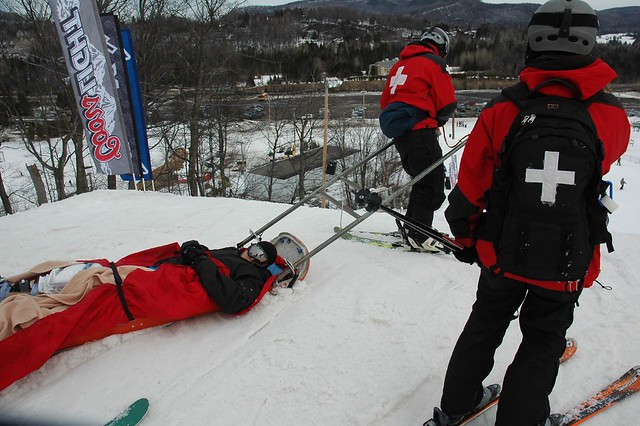In quality products, performance is often the main criteria.
What should you expect from your telemark gear?
If it’s good stuff when we buy it, we are left with one question: how long it’s gonna last?
I try a lot of new gear every year. And have been doing so for more than 10 year now. I get new skis, new boots, new poles, new pack, new everything. But I also have stuff I keep for many season because I like it. I usually keep a quiver ski 2-3 years and use it untill the ski is really dead (I ski 120 days a year). Same for boots and boot liners. I have a pair of old liner I keep, There my slippers. But I can’t argue that new stuff will perform like no other.
In telemark, quality is not a problem since most gear is high end. (compare to alpine gear or snowboard which have all quality grades including low quality)
I think it’s because of the size of the market, there is no room for cheap. Good for us.
SKIS:
It is well known that skis have a life expectancy. That it soften with time and will loses its snap. But just how long. This may vary depending on the ski construction, the usage of the ski, the type of skier and so on. One thing is for sure, after 50 days of skiing, the ski as changed and is not the same. But it’s definitely still good. After 200-300 days, It’s usually very dampened, and you want to change it. (you can always keep an old pair for rocky/thin snowpack conditions)
Maintenance: Edge Wear
Keeping your ski edges sharp is generally neglected on the telemark scene. If you ski powder every day, it’s obviously not as important. But even then, sharp edge will make a difference on high traverse, on that couloir that avalanched half way down and that is now frozen hard. For the daily telemark skier, telemark edges is the difference between: “wow, I have great skis, the rip through every thing”, or “I don’t feel confident, these skis s…”
Mark my words, sharp edges are key to 80% of good telemark technique. If you do it bad with sharp edges, you have a chance. If you do it good on round edges, you have no chance.
Make a habit to sharpen your skis every 2-3 days on the mountain. It will not take you long and you will get better at it very fast. You can go crazy with edges sharpness. DON’T. Just take a simple file and work the edges. I tried to find a simple video on the Web but I didn’t. So I’ll made one in the weeks to come.
Base wear:
Wax your skis from time to time. This is a question a moving fast on flats more than downhill performance. There are different kind of wax depending on snow temperature and performance. I use a cheap, general wax. For real cold snow, -20c (-5F) and below or spring/wet snow (above freezing point), it’s a good idea to have an adapted wax.
Ski base are meant to be flat. With time, it will need to be flatten to keep a good glide. This needs to be done at your local ski shop and cost around 30-40$ (stone grind). This is not the most important but can be done once a year. With a stone grid comes wax and edge tuning which facilitates hand edges tuning since you start with a constant edge surface. Grinding your base flat too often will reduce the life of your skis. (varies with the ski type, just don’t do it every week!)
TELEMARK BOOTS:
Boots wear out. Yes. It takes a while but the plastic definitely soften with time. Especially at the bellows, especially for the aggressive low stance telemarkers. And it affect performance. It’s hard to put a time on its life expectancy but if you haven’t change in a while, you won’t believe the difference it makes in the performance (I’d say 200 days) Liners will pack and your foot won’t have the same drive force to the ski. You can remold boot liners many times. (usually 5-6 times) so don’t be afraid to try it out.
Maintenance: Boots
Telemark boots don’t really need maintenance. Have the liners molded for comfort (you can do it home quite easily). Remove and dry the liners after each use.
TELEMARK BINDINGS:
If there is one thing that doesn’t wear out, it’s the bindings, right? almost.
Even telemark binding wear out. Usually the spring cartridges will loosen in the first few days. I notice stiffer spring cartridges usually loosen more and faster, which, in my opinion, makes them useless. Just buy regular spring cartridges for your bindings. After that, bindings won’t wear much for a lot of days on the mountain. Inspect them carefully before going out on a trip for unusual wear, check the screws torque tension and you should be fine. The end of life of a telemark binding is usually the purchase of a new ski (and you want to sell your old pair with bindings). If not,you can generally mount bindings over again without problems. Some ski techs will change the screws, it’s not a bad idea but not 100% necessary. As mentioned in the post: Gear talk: where to mount your telemark binding, get a knowledgeable technician to mount your binding or, one day, it will probably rip out. Technology improvement is an other good reason to change your binding once every few years.

Bonus:
I’m not a fan of fashion and of consuming new gear for the sake of it. But their is a difference between planned obsolescence and perceived obsolescence. At least the telemark industry creates good product and their planned obsolescence is more durable than other outdoor products.
- Make the most out of your gear. Use it, maintain it.
- Change it before it get worn out. Performance is more than a luxury.
- Considering that a regular telemarker usually ski 20-30 days a year, I consider the stuff we pay for can last between 5 to 10 years.
- Technology evolve faster than the life expectancy, you can always sell your old stuff before it is worn out. And you will make a ski bum happy.
Don’t forget to subscribe to our free email updates. Lots of cool stuff coming up.
































What others think about it